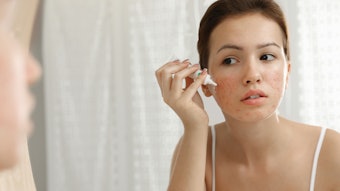
To determine aesthetic interventions that provide the most rejuvenation for photoaged skin, researchers at the department of plastic and reconstructive surgery, Nanfang Hospital, Southern Medical University in Guangzhou, People’s Republic of China, used a mouse model to compare treatments of stromal vascular fraction gel, fat, tretinoin or phosphate-buffered saline. The outcomes of the study were published in Plastic and Reconstructive Surgery (October 13, 2021).
Related: SVF Gels Offers Long-term Improvement for Infraorbital Hollows
The authors established a UV-induced photoaging model in nude mice. The mice then received treatments of either stromal vascular fraction gel, fat, tretinoin or phosphate-buffered saline. Photoaging skin was characterized by histologic and immunohistochemical analyses, and expression of collagen synthesis–related or photoaging-related genes was assessed before and after treatment.
They found that stromal vascular fraction gel, fat and tretinoin all reversed photoaging, with stromal vascular fraction gel demonstrating the greatest therapeutic effect.
Related: SFV Does Not Enhance Efficacy of PRP
Treatment with stromal vascular fraction gel restored intradermal fat tissue content and increased dermal collagen density. Injection of stromal vascular fraction gel had the strongest effect on stimulating fibroblasts and increasing the expression of transforming growth factor β1 (TGF-β1), propeptide of type-I procollagen and Smad 2, and decreasing the expression of Smad 3, compared with fat and tretinoin. Expression of photoaging-related genes was significantly reduced, whereas expression of fibulin-5 was significantly increased after stromal vascular fraction gel treatment.
Related: Free Fat Grafts Spur Regeneration of Adipose Tissue
They concluded that stromal vascular fraction gel, which can be injected intradermally and survive within dermal layer after grafting, demonstrated “remarkable therapeutic effects in reversing photoaging skin. This product increased TGF-β1 expression and activated fibroblasts to produce propeptide of type I procollagen, thus increasing the amount of collagen I, leading to thickening of the dermis of photoaging skin.”











